Christopher Caines directs and choreographs Purcell’s Fairy Queen for the Dell’Arte Opera Ensemble.
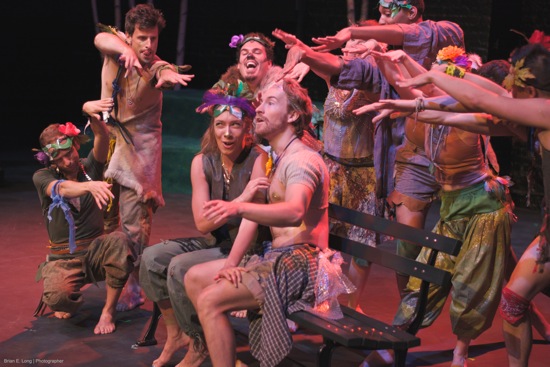
Purcell’s The Fairy Queen and Shakespeare’s midsummer immortals.
L to R: Peter Thoresen, Julian Whitley, Tamra Paselk, John Collison. Above the seated pair: Raymond Storms. Photo: Brian E. Long
If I had looked carefully at the program for The Fairy Queen before the Dell’Arte Opera Ensemble’s ambitious conflation of Henry Purcell’s opera and Shakespeare’s A Midsummer Night’s Dream had begun, I might have been tempted to make a run for it. Here, for example, are the roles that actor Zach Libresco is listed as playing: Demetrius: Dalton ’14, Harvard ’18, Helena’s ex-boyfriend; Tom “Snug” Snout: cabaret singer, proofreader.
But I stayed, luckily, for this raucous, outrageous, giddy, and mostly delightful downtown production, that the Dell’Arte Ensemble is presenting as part of its “A Summer of Shakespeare.” (See: http://www.dellarteopera.org/season.php5?p=58). Christopher Caines directed and choreographed The Fairy Queen, in addition to choosing and adapting elements of both texts. The night before, I had seen Handel’s Acis and Galatea, staged and choreographed by Mark Morris and performed at Lincoln Center. To see The Fairy Queen (on view through August 23), you head for the East Village, enter the tiny Everyman Café, locate the box office, and five or six steps later, you’re in the East 13th Street Theatre’s black box, with the audience seated on three sides.
Not exactly culture shock, but a more intimate and far less grand setting, in addition to a great deal of imagination at work. Intimacy is not just an overall concept in this case. The eight skillful players in the early-music ensemble, The Sebastians, along with their harpsichordist and musical director, Jeff Grossman, sit so close together at the edge of one bank of seats that when Charles Weaver lays down his lute and picks up his long-necked theorbo, you fear for violinist Daniel S. Lee’s music stand, and a few members of the audience will hear cellist Ezra Seltzer as dominant. He’s that close to them.
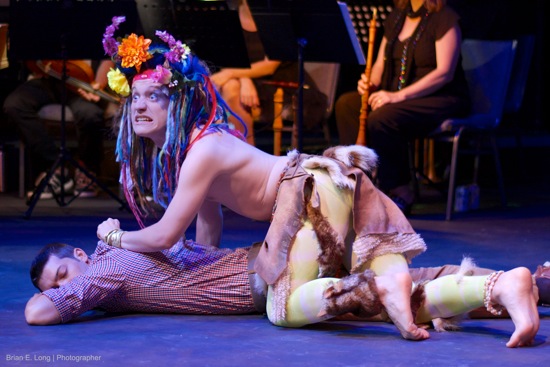
Drew Paramore as Puck and Seth Shirley as Lysander in Dell’Arte Opera Ensemble’s The Fairy Queen. Photo: Brian E. Long
The songs and interludes (possibly intended for dancing) that make up The Fairy Queen allude to, and embroider upon the plot of Shakespeare’s play without making use of its text; presumably those who attended Purcell’s semi-opera around 1692 were familiar with the play that Shakespeare had written a hundred years before. Purcell’s work was divided into five masques that could be interpolated between scenes drawn from the play and serve as a final wedding celebration (it would have made for a very long evening in the theater).
You know what you’re in for on East 13th Street when Puck (the endearing, hyper-active Drew Paramore) makes his welcoming speech. Oberon’s agile henchsprite manages to shoehorn information about exits and cell phones into the Bard’s chosen iambic pentameter. Hermia (Amanda Goble) arrives dragging a little orange wheelie. Apparently this is no English forest but Central Park, where the four mixed-up lovers—Hermia, Lysander (Seth Shirley) Helena (Cassandra Stokes Wylie), and Demetrius (Libresco)—arrive for a reunion and perhaps an elopement (they were schoolmates at Dalton. A park bench is part of the minimal scenery. The little pageboy that Oberon and Titania squabble over is a child (Gabriel Griselj) kidnapped by Puck, whose distraught Spanish-speaking nanny (Elisa Toro Franky) keeps passing through in search of him.
I could do without some of the mischievous inserted updates to the text, such as references to a Brooks Brothers suit, but these are minimal, and the fragmentary rap routine tossed off gleefully by Bottom (Andrew Gelles) when he is transformed back from an ass to his human self (apparently he’s a word processor by day) is an engaging little surprise.
What with the double-casting and the present-to-past switches, it’s easy to get confused, but, bar a few moments when I want to wince, I’m easy with that. Caines even brings in, for a few seconds, another theatrical quartet arguing about identity and who loves whom; suddenly Shakespeare’s lovers become Gwendolyn, Cecily, Algernon, and Jack from Oscar Wilde’s The Importance of Being Earnest —that is, the actors playing their presumed Shakespearean roles find themselves in another drama (surely a nightmare that many actors have).
All the actors perform convincingly. Shirley, Libresco, and Stokes Wylie modulate their voices more skillfully than do Imani Jade Powers (Titania and Athena) and Goble (whose diction sometimes makes her words unclear). It’s easy for the women to become shrill, and sometimes one actor or another seems more intent on coloring individual words than shaping the sense of a line. But they’re all lively, and they work wittily together.
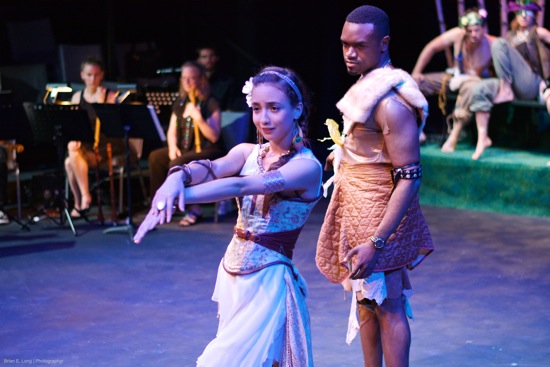
Titania (Imani Jade Powers) and Oberon (Jason Duvernau) of A Midsummer Night’s Dream. Photo: Brian E. Long
Eleven singers of the Dell’Arte Opera Ensemble (three sopranos, three countertenors, two tenors, two baritones, and a bass) fill all the roles in The Fairy Queen. They get a workout. Four of the men (Andy Berry, John Collison, Nathan Létourneau, and Brennan Hall) are Shakespeare’s four fairies, but, for example, Berry (a bass) also plays Purcell’s drunken, stammering poet (a take-off on a rival on the composer’s part?), Sleep, Hymen, and the dopey shepherd Corydon (with be-wigged countertenor Peter Thorsen as shepherdess Mopsa fending him off with “No kissing! No, no!” ).
Purcell wrote all manner of arias—summoning ones, frolicking ones, joyous ones, lovelorn ones, and somber ones (like the ravishing “Now let me weep,” sung eloquently by Tamra Paselk at the performance I attended). The composer plays with sudden dramatic stops and, in one song, with echoes. Each of the very gifted singers—including Raymond Storms, Julian Whitley, Leslie Tay, Noelle McMurtry, and Elizabeth Westerman—has at least one aria to deliver. Purcell wrote songs for each of the fours seasons; for Night, Mystery, Secrecy, and Sleep; for Apollo, Juno, Daphnis, Chloe, and Hymen. These are beautiful, lilting pieces of music, with large amounts of fioritura. The singers’ task of keeping their tone pure and tremolo at bay, in order to contrast “simple” singing with these virtuosic embellishments, is a demanding one (among the women, McMurtry is especially skilled at this).
Caines has made intriguing choices that affect how we experience this complex work. In a sense, he is working in miniature, trying to create musical and dramatic richness with minimal means. The choices involved making all the singers first and foremost be fairies in Oberon and Titania’s kingdom, onstage almost constantly. Watching them, you may or may not know, say, that Tay is being Autumn when he sings of many-colored fields and some singers form a tree from which others gather apples; he’s just one in the band of imaginative sprites with silvery voices who is taking charge for a while.
“Sprites” is possibly the wrong word. “Fairies” too. Nina Bova has attired the denizons of the woods in skimpy assemblages of clothing. Flannel, leather, fur, and belts randomly arranged, plus cockeyed flower garlands on their heads and odd touches of makeup give them the look of uninhibited homeless people making the best of what they can find. Oberon (Jason Duvernau) is the somewhat thuggish guardian of their world. Caines has given them animal manners, which they’ve taken on with impressive zeal. When not singing (and sometimes while singing), they crawl around, crouch, nuzzle one another, and snuggle together like a pack of puppies. They’re rowdy, sensual verging on sexual, and alert to every change of mood or character. That the beautiful voices emerge from these ardent rag-tag creatures is itself moving. No wonder the little boy that Puck has brought into the magic world seems delighted to be there.
Yes, there are awkward moments, devices that don’t quite work, and behavior that goes against your (well. . .my) idea of Shakespeare’s created world. No matter how much I try to justify the five inserted pas de deux that are performed—apparently to entertain the fairy court—by Aynsley Inglis and Luke Tucker, I can’t manage it. The nicely made duets are too conventionally balletic, and everything comes to a halt when the two dancers appear, except for one brief interaction between them and little Griselj. All but one of their short numbers, as I recall, involve pointe shoes, and for the final one, Inglis sports a tutu. What’s the deal? Did they get lost trying to find Lincoln Center? Still the flaws don’t detract significantly from the artful, brave, and highly entertaining production.

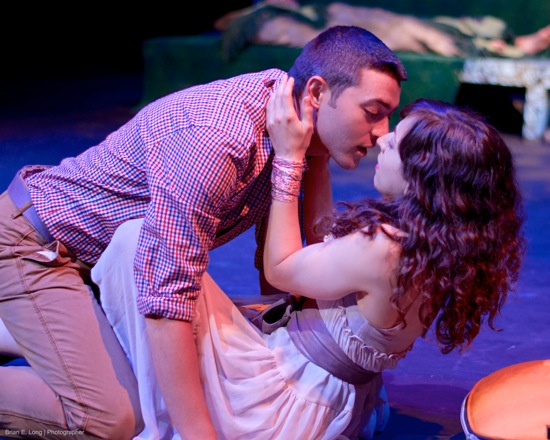
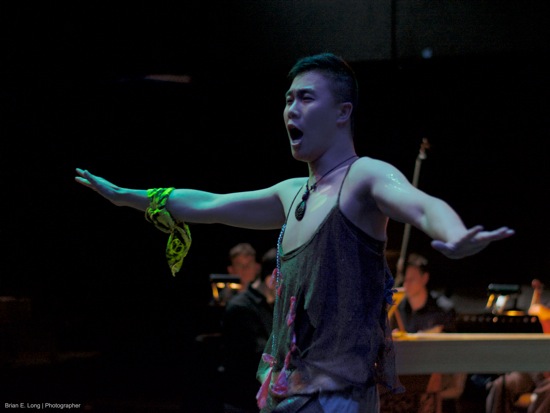
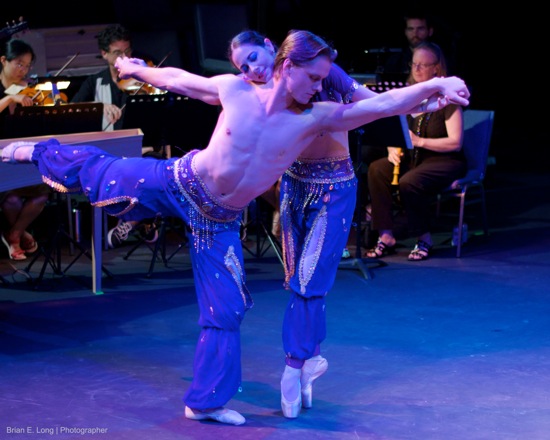
The ballet is in it because the Fairy Queen was a ballet performed by Sadler Wells Ballet with Covent Garden Opera December 12, 1946 choreographed by Frederick Ashton. The dances you saw were performed by ballerinas including Margot Fonteyn.
Christopher Caines, as an extremely knowledgeable choreographer, may well have intended to allude to the interludes that Ashton contributed to that 1946 production of The Fairy Queen. However, the pas de deux we saw were not by Ashton, but by Caines himself.
There were 3 pas de deux and yes Mr . Caines did the choreography. The comment referred to your writer’s confusion regarding ballet being in the Fairy Queen and his comment on pointe shoes and being lost on the way to Lincoln Center. Indeed in the book The Fairy Queen published in 1948 by John Lehman with photo plates by Edward Mandinian – Margot Fonteyn, Moira Shearer, Beryl Grey, Gillian Lynne, Margaret Dale and the dozen corps de ballet members are all in pointe shoes . The Spirits of the Air pas de deux with Margot Fonteyn and Michael Somes Act II Scene II was very much a classical ballet pas. Merely enlightening the reporter that The Fairy Queen, still performed in Canada and Australia as a ballet/opera and a few years ago offered by American Ballet Theatre has a 50 year us history with classical ballet, tutus and pointe shoes.